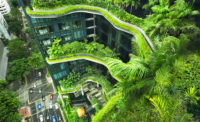The Greening of Architecture in Southeast Asia
Architects & Firms
In the present environment of instant communications and global architectural practices, the swirl of influences between East and West is as dynamic and complex as the trade winds that blow between continents. This pair of publications, EcoArchitecture, The Work of Ken Yeang, by Sara Hart, and WOHA: Selected Projects Volume 1, by Patrick Bingham-Hall, captures the complexity and promise of this moment.

WOHA: Selected Projects, Volume 1, by Patrick Bingham-Hall. Pesaro Publishing, 2011, 280 pages, $65.
EcoArchitecture: The Work of Ken Yeang, by Sara Hart. John Wiley & Sons, 2011, 272 pages, $75.
EcoArchitecture features 22 of Yeang’s most significant projects dating from the Roof-Roof House of 1985 through more complex projects such as the DiGi Technical Operations Center in Shah Alsam, Malaysia of 2010. It represents the first comprehensive overview of perhaps the most important architect to come out of Southeast Asia in the modern era. Yeang’s most notable achievements have been in rethinking the skyscraper, “arguably the least environmentally sustainable building type civilization has yet devised,” says the book’s author, Sara Hart. This work has had a growing but unmistakable influence on the design of the most recent generation of tall buildings. It established him as one of the major figures in the field of sustainable design.
With a preface by Norman Foster, an introduction by John Frazer of the University of Ulster, and a concluding essay by Yeang, EcoArchitecture encapsulates over 30 years of sustained theoretical exploration and the application of this research to increasingly complex built projects. If the Pritzker and AIA Gold Medal juries ever went beyond a preoccupation with form-makers and instead chose to recognize how architecture can use research, thought leadership, and design exploration to reshape the way society organizes itself, EcoArchitecture might be one of the a primary exhibit for a figure who has earned a place on the short list for these prizes.
The decidedly didactic tone of EcoArchitecture comes through in the climate region and vegetation zone maps and computational fluid dynamic diagrams that are of minimal interest to clients but integral to the approach Yeang calls “bioclimatic design.”
If EcoArchitecture is the edifying retrospective on an established figure, WOHA: Selected Projects Volume 1 may best be seen as a coming-of-age party for one of the region’s significant new talents. WOHA: Selected Projects is less an explication of theory than an illumination of the thought process and inspirations of the firm’s two founders, Singapore native Wong Mun Summ and Australian-born Richard Hassell.
The seven projects in the monograph represent highlights of an astonishingly productive 11-year period during which the Singapore-based firm has built major retail, residential, and hospitality projects with ingenuity and flair. WOHA’s application of formal influences—ranging from Arquitectonica to the Japanese Metabolists—to the physical and cultural realities of Singapore’s tropical climate and affluent consumerist society, often yields spectacular results.
Projects such as The Met—a vertically sliced residential highrise in Bangkok that frames soaring skygardens—represent typologically driven adaptations of Modernism to a tropical setting and follow Yeang’s earlier climate-driven explorations. Another project, the Alila Villas in Bali, came from the architects imagining what might happen if “Mies van der Rohe and Carlo Scarpa paid a visit to a Majapahit emperor.” High-quality, full-bleed photos add to the pleasure of reading this book, while its interview format is both informal and informative.
Eric C. Y. Fang is an associate principal at EE&K, a Perkins Eastman Company, where he leads large-scale urban design and sustainable redevelopment projects throughout the U.S. and abroad.




.jpg?height=200&t=1713468361&width=200)
